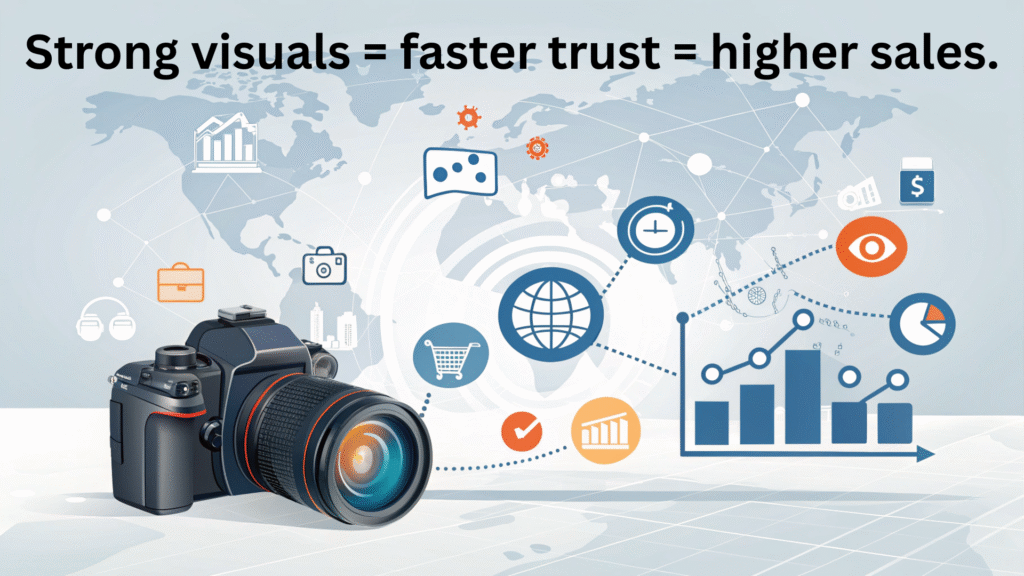
19th August marks World Photography Day. For most people, it’s a celebration of creativity, artistry, and passion. Yet, when we shift lenses to the world of commerce, photography often gets dismissed — seen as a cost rather than an investment.
As someone who has been exploring photography for over two decades, and consulting with businesses for just as long, I have observed a consistent paradox: companies bargain hard with photographers, distrust their pricing, and often treat visuals as an afterthought. But ironically, these very images are what fuel their sales, branding, and customer trust.
Can You Imagine a World Without Images?
Think about your daily life:
- You wouldn’t buy food online without seeing how it looks.
- You wouldn’t choose a hotel without browsing through pictures of the rooms.
- You wouldn’t click “Add to Cart” on Amazon without seeing multiple product angles.
- Reading the news without photographs of events.
Unthinkable, isn’t it?
Our eyes process visuals 60,000 times faster than text. In fact, studies show that 93% of consumers consider images essential in purchase decisions. Without photographs, trust collapses. And without trust, there is no sale.
The Numbers Speak Louder Than Words
For the business-focused LinkedIn reader, let’s put some hard data on the table:
- Amazon found that products with high-quality images see up to 3x higher conversion rates compared to those with poor visuals.
- Airbnb reported that professional photography increased bookings by 40% and allowed hosts to charge 26% higher nightly rates.
- Shopify research shows that customers who view 3 or more product images are 65% more likely to complete a purchase.
- A study by Justuno revealed that 93% of consumers say visuals are the key deciding factor in a purchase.
Photography isn’t art alone. It’s revenue.
Case Studies That Prove the Point
Case Study 1: Amazon Amazon doesn’t just sell convenience; it sells clarity through images. Each product is photographed from multiple angles, often with zoom features and lifestyle shots. Their A/B testing revealed that listings with richer visuals consistently outsold text-heavy listings — proving photography is central to their trillion-dollar empire.
Case Study 2: Airbnb Early in its journey, Airbnb realized listings with poor-quality photos were struggling. They rolled out a professional photography program and saw an immediate 40% jump in bookings. Hosts could also charge higher, simply because trust is built through visuals.
Case Study 3: Zomato In the food delivery space, Zomato noticed restaurants with professional food photography received 61% more orders compared to those using low-quality or stock images. The appetizing visuals directly drove revenue for both restaurants and the platform.
But What About AI? Will Photography Become Obsolete?
Today, AI can generate stunning images at the click of a button. Many businesses wonder: does this make photography redundant?
I believe the answer is No. AI is not a threat but a powerful tool to augment photography. AI-generated visuals can be fantastic for creative campaigns, mockups, or storytelling. But when it comes to commerce, authenticity is king. Customers trust what they can believe. If your AI-generated burger looks juicy but the real product disappoints, trust — and sales — collapse.
Photography roots commerce in reality and honesty. AI can support it, but it cannot replace it.
Final Frame
On this World Photography Day, let’s pause to recognize photography not just as an art form, but as a strategic driver of business growth.
Behind every sale, every booking, every order, there was first an image that convinced the buyer. And it’s high time businesses start treating photographers not as cost centers, but as growth partners.
Because in today’s world, sales don’t just begin with a conversation. Sales begin with a picture.
👉 Read more leadership insights in my book: The Corporate Arjuna